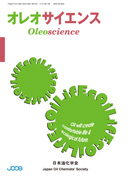All issues

Volume 8, Issue 11
Displaying 1-3 of 3 articles from this issue
- |<
- <
- 1
- >
- >|
-
Toshiharu NOGUCHI2008Volume 8Issue 11 Pages 479-485
Published: November 01, 2008
Released on J-STAGE: June 01, 2013
JOURNAL FREE ACCESSThis paper shows the recent advancements on laundry detergents and their related technologies which have been continuously reinvented to meet the changing consumers' lifestyles and expectations. Laundry detergents are indispensable for daily lives, consequently, their annual production amounts to almost 770 thousands tons nationally. In 1987, the concentrated laundry powder detergent was launched in Japan and immediately prevailed in the market. More concentrated powders, laundry tablets and laundry sheets were developed and launched afterward. In 2001, the new laundry powder detergent appeared which realized the significantly quick dissolving property to meet the changing washing machines & conditions and consumer requirements and improved the detergency as well. In recent years the function-added products have been consistently launched, which provide not only washing performance but also other functions such as bleaching, anti-bacterial and/or softening abilities. In the background of these product advancements, the development of new manufacturing processes and ingredients have been proactively pursued.View full abstractDownload PDF (1758K) -
Evaluation methods and new functionsHirohiko TADENUMA2008Volume 8Issue 11 Pages 487-493
Published: November 01, 2008
Released on J-STAGE: June 01, 2013
JOURNAL FREE ACCESSThe most fundamental request for laundry detergents is the efficiency of washing. As widely accepted, the efficiency is affected by many conditions such as a wide variety of soils and stains, type of fabric, extent of mechanical agitation, cloth/wash-liquor ratio and so on. Therefore, many laundry detergent manufactures have been trying to improve the performance of detergents including the development in the evaluation methods of detergency. Recently, as the washing circumstance has changed, the various performances have been requested for the detergents by the consumers. In this paper, I describe the general evaluation method of washing performance and new functions of recent detergents.View full abstractDownload PDF (1274K) -
Tomiichi HASEGAWA2008Volume 8Issue 11 Pages 495-501
Published: November 01, 2008
Released on J-STAGE: June 01, 2013
JOURNAL FREE ACCESSResearches on mechanical force in textile washing have been reviewed. Mechanical force exerts its effect through various factors; bending, friction and elongation of textile, and the flow on the textile surface or the flow between yarns or fibers. The present report mentioned positioning and meaning of researches so far carried out on these factors. Also, the author introduced washing methods developed for the purpose to reduce energy and detergent by utilizing the mechanical force positively. Furthermore, he stated both the fluid property and the dynamic surface tension of liquids concerned with washing. In particular, the following two points were stressed : (1) Energy provided to textile is effective below its certain value, but it is of no use beyond the value and the excess energy is only wasted. (2) Aqueous solutions of detergent provide an effect to reduce the drag of flow through yarns or fibers and to increase the flow rate, resulting in easier removal of soil than in water, as well as the effect to lessen the chemical potential between soil and substrate.View full abstractDownload PDF (1197K)
- |<
- <
- 1
- >
- >|